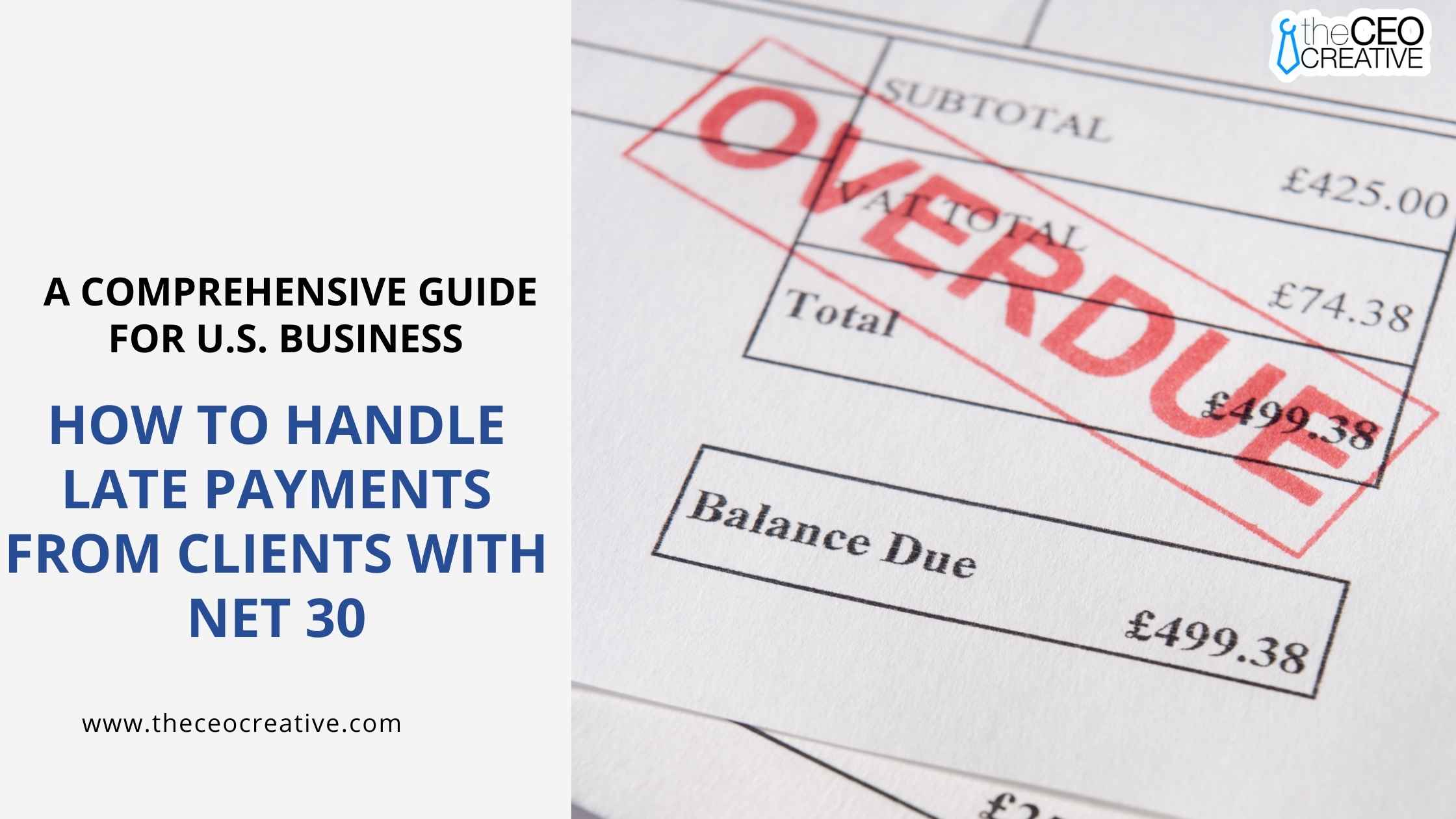How to Handle Late Payments from Clients with Net 30
Navigating the financial waters of running a business in the U.S. means understanding how to master Net 30 payment terms. These terms provide a comfortable cushion of 30 days for buyers to settle their invoices, but late payments can create significant ripples in a seller’s cash flow.
This guide aims to arm you with the knowledge and strategies needed to effectively manage Net 30 late payments, ensuring the financial health of your business remains strong. With this roadmap, you’ll be better prepared to handle the challenges and opportunities that come with these common payment terms.
Understanding Net 30
Let’s dive right into the world of Net 30 – a term you might encounter often if you’re in the business world. But what exactly is Net 30, and why does it matter so much? Let’s explore!
Definition and Importance
At its heart, Net 30 is a payment term that specifies that a buyer has 30 days from the invoice date to pay the seller. This term is quite common in business-to-business (B2B) transactions. It provides a win-win situation by offering some breathing room for buyers to manage their finances while still ensuring sellers get paid. It’s all about balance.
For buyers, the allure lies in having a bit of extra time to juggle their cash flow. This means using the bought goods or services to possibly generate more income before having to pay up. Essentially, it’s like short-term financing that can help keep the lights on and the wheels turning in times of tight budgets.
Sellers, on the other hand, might look at Net 30 as a way to reel in customers. It makes your business attractive, allowing potential clients to ease into a purchase without immediate financial pressure. However, it also puts sellers in a waiting game for their payments, which can be nerve-wracking if cash flow is crucial for operations.
Buyer’s and Seller’s Perspectives
When it comes to Net 30, both buyers and sellers have unique views, and understanding these perspectives can help make the process smoother:
– Buyer’s Perspective: They see it as an opportunity to:
– Strategically allocate funds.
– Generate revenue before payment deadline.
– Utilize short-term financing without the hassle of a loan.
– Seller’s Perspective: They value it as:
– A tool to attract and retain customers.
– A means to foster loyalty and stimulate sales.
– Despite the delay, a strategic choice in competitive markets.
Now that we’ve unpacked what Net 30 is and why it’s important, let’s turn our attention to why late payments can occur, even with clear terms like these.
Causes of Late Payments
- Financial Hardships
- Administrative Oversights
- Strategic Delays
Recognizing why payments can be late is key to managing them effectively. Late payments can be a real headache, but understanding the main culprits can help you tackle them head-on.
1. Financial Hardships
Financial difficulties are often at the root of late payments:
– Economic Downturns: When the economy takes a nosedive, businesses may struggle to keep up with their cash flow, putting your invoice on the backburner.
– Internal Financial Mismanagement: Sometimes, it’s not external forces but internal chaos that causes delays. Poor financial planning or surprise expenditures can throw a wrench into the payment works.
2. Administrative Oversights
Sometimes, late payments are simply a result of internal hiccups:
– Lost Invoices: Ever lost a sock in the laundry? Well, the same can happen to invoices! Misplaced paperwork often results in unintentional delays.
– Inefficient Processes: An approval process that moves at a snail’s pace or messy handling of invoices can slow things down.
3. Strategic Delays
There are instances where delays are intentional:
– Cash Flow Optimization: Some companies might choose to hold onto their cash a little longer to optimize their own working capital, even if it inconveniences others.
– Exploiting Loopholes: Taking advantage of any leniencies in your collection processes, buyers might delay paying their dues.
Being aware of these causes allows you to prepare better strategies to handle overdue payments and maintain your business’s cash flow. In our next sections, we’ll explore both the costs associated with these late payments and effective methods to manage them, helping you keep your finances in check, even when faced with delays.
The Cost of Late Payments
Navigating through the stormy sea of late payments in the world of Net 30 can be more than just a financial headache. They can also bring along a range of costs that impact your business in various aspects. Let’s dive deeper into these hidden costs.
Financial Costs
1. Cash Flow Disruptions: When payments lag behind, it’s like trying to drive a car with an empty fuel tank. Your ability to pay bills, staff, or suppliers takes a hit, which can put crucial growth plans on halt.
2. Interest & Late Fees: If you have a policy that includes late fees or interest charges, these can pile up, cutting into your profits like a double-edged sword.
3. Collection Expenses: Whether you’re spending resources reaching out to slow-paying clients or hiring collection agencies, the costs associated with this can accumulate quickly.
4. Bad Debt Write-offs: In some cases, non-payment might lead to debts being written off as losses, directly affecting your bottom line.
Operational Costs
1. Administrative Burden: Chasing down late payments is not only exhausting but also diverts time and manpower away from important business tasks.
2. Lower Employee Morale: Dealing with financial uncertainty from late payments can be demoralizing, affecting overall productivity and enthusiasm across the team.
3. Missed Business Opportunities: With cash tied up in delayed payments, investing in new ventures or seizing growth opportunities becomes a real challenge.
Intangible Costs
1. Strained Customer Relationships: While it’s essential to get paid, persistent chasing can hurt client relationships, risking future business engagements.
2. Reputation Damage: A business known for having payment troubles might scare off potential clients or partners, impacting its brand and reliability.
3. Stress & Anxiety: The constant worry over cash flow can take a toll on the mental health of both business leaders and their teams.
Being aware of these costs emphasizes why preventing late payments should be a top priority.
Preventive Measures
 Image courtesy: Unsplash
Image courtesy: Unsplash
The best approach to dealing with the menace of late payments is to stop them from happening in the first place. Establishing strong preventive measures can make all the difference.
Crystal Clear Communication
1. Explicit Terms: Make sure your payment terms, such as Net 30, are clearly stated on invoices, contracts, and all communication with clients. Ambiguity is your enemy here.
2. Late Fee Policy: Be upfront about any late fees you might charge, specifying the amounts or percentages to ensure clients are fully aware.
3. Payment Reminders: Setting up automated reminders a few days before due dates can often prevent accidental oversights by clients.
Creditworthiness Assessment
1. New Clients: Conduct credit checks or ask for references for new high-value clients. This helps in assessing their financial stability and previous payment behavior.
2. Existing Clients: Keep an eye on payment patterns. If existing clients start showing late payment tendencies, it might be time to re-evaluate their terms or credit limits.
Flexible Payment Options
1. Online Payments: Offering multiple online payment options like credit cards, ACH transfers, or digital wallets makes paying on time easy and convenient for your clients.
2. Installment Plans: For larger bills, consider installment plans to help clients manage payments over time without too much financial strain.
3. Early Payment Discounts: Encourage prompt payments by offering discounts for early transfers. This can be a win-win for both parties involved.
By incorporating these preventive measures, your business can establish a solid framework that reduces the chances of late payments, maintains healthy client relationships, and secures financial stability. Keep these tactics in mind and you’ll be better prepared to handle any surprises that come your way, with confidence and poise.
Conclusion
Dealing with Net 30 late payments can be daunting, but U.S. businesses can learn how to handle late payments from clients strategically. By understanding Net 30 terms, anticipating causes of late payments, and implementing preventive measures, you can ensure smoother financial operations.
Focus on clear communication and foster solid relationships with your clients while making it easy for them to pay you on time. Remember the vital role of assessing creditworthiness and offering flexible payment options. By prioritizing proactive strategies, businesses can protect their cash flow and stay on a path to success.
Empower your business to tackle late payments confidently and preserve your financial health. With the right tools and approach, you’ll enhance efficiency, improve customer satisfaction, and solidify your business’s reputation in the competitive landscape.






